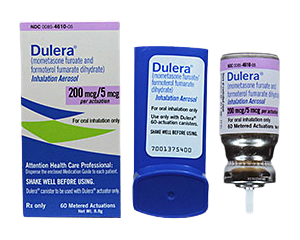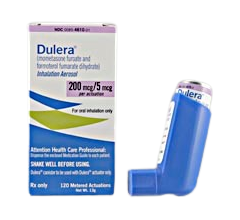Dulera is a trusted prescription medication designed to effectively manage and prevent asthma symptoms, providing relief and improved breathing. By combining the power of a long-acting bronchodilator and an anti-inflammatory corticosteroid, Dulera offers a comprehensive approach to asthma control.

What is Dulera inhaler?
Dulera 5mcg/200mcg is indicated for controlling and preventing asthma symptoms, including wheezing, in adults and adolescents 12 years of age and older. It is a prescription inhaler that combines two active ingredients: formoterol fumarate and mometasone furoate. It is primarily used for the maintenance treatment of asthma.
Formoterol fumarate is a long-acting beta-agonist (LABA) bronchodilator that helps relax the muscles in the airways, making breathing easier. It works by stimulating beta-2 receptors in the smooth muscles of the airways, leading to bronchodilation and improved airflow.
Mometasone furoate is a corticosteroid that acts as an anti-inflammatory agent. It helps to reduce inflammation in the airways, thereby decreasing symptoms such as wheezing, coughing, and shortness of breath associated with asthma.
By combining formoterol fumarate and mometasone furoate in a single inhaler, Dulera provides both bronchodilation and anti-inflammatory effects, making it a convenient option for asthma management. It is typically used regularly to prevent asthma symptoms and should not be used as a rescue inhaler for sudden asthma attacks.
NDC code is 0085-7206
Clinical Pharmacology
The mechanism of action of Dulera involves the combined effects of its two active ingredients.
Formoterol fumarate (a long-acting beta-agonist) stimulates beta-2 adrenergic receptors in the smooth muscles of the airways. This leads to the relaxation of the bronchial muscles, resulting in bronchodilation and improved airflow. By opening up the airways, formoterol helps to alleviate symptoms such as wheezing and shortness of breath associated with asthma.
Mometasone furoate (an inhaled corticosteroid) is an anti-inflammatory medication that works by inhibiting the release of inflammatory mediators and reducing the recruitment and activation of inflammatory cells in the airways. It helps to decrease swelling and inflammation in the airway tissues, reducing the frequency and severity of asthma symptoms.
This combination helps to control asthma and maintain optimal lung function.
Ingredients
The components of the medication are the following:
- Mometasone furoate – 200 mcg;
- Formoterol fumarate dihydrate – 5 mcg.
What Are the Dosages of Dulera?
The standard dosage for a Dulera inhaler with a strength of 5mcg/200mcg per actuation is as follows.
For patients 12 years of age and older:
- The recommended starting dose is 1 inhalation twice daily (morning and evening), for a total daily dose of 2 inhalations.
- The maximum recommended daily dose is 2 inhalations twice daily, for a total daily dose of 4 inhalations.
The dosage may vary depending on individual factors, such as the severity of asthma and the patient’s response to treatment. Therefore, it’s essential to follow the specific instructions your healthcare professional provides or as indicated on the prescription label. They will determine the appropriate dosage based on your unique condition and adjust it if necessary.
It’s crucial to use Dulera regularly as prescribed, even if you are not experiencing symptoms. Stay within the recommended dosage unless instructed by your healthcare provider.
To properly use the Dulera inhaler, follow these general steps:
- Remove the cap from the mouthpiece and shake the inhaler well. Check the dose counter to ensure that enough doses are remaining.
- Breathe out completely, away from the inhaler, to ensure your lungs are empty before inhaling the medication.
- Hold the inhaler in a level, horizontal position with the mouthpiece facing you, and place your thumb on the base of the inhaler. Make sure your fingers are not covering the vents.
- Take a slow, deep breath through your mouth, and as you inhale, press down firmly on the top of the inhaler to release the dose. Continue inhaling steadily and deeply to ensure the medication reaches your lungs.
- After inhaling, remove the inhaler from your mouth and hold your breath for about 10 seconds, or as long as comfortable, to allow the medication to deposit in your airways.
- Breathe out slowly and gently away from the inhaler.
- Rinse your mouth with water without swallowing after using the inhaler to minimize the risk of oral thrush or other mouth and throat irritation. Spit out the water.
- Replace the cap on the mouthpiece to protect it until your subsequent use.
It’s essential to read and follow the specific instructions provided with your Dulera inhaler, as there may be slight variations in usage.
Important Safety Information
Dulera is not a rescue inhaler and should not be used for sudden asthma attacks or worsening symptoms. Always keep a fast-acting bronchodilator inhaler (e.g., albuterol) for immediate relief.
Like other long-acting beta-agonists (LABAs), formoterol (an active ingredient in Dulera) may increase the risk of asthma-related death. It is essential to use this medication exactly as prescribed and follow your healthcare professional’s instructions.
Mometasone furoate (an active ingredient) is a corticosteroid. Prolonged use of high doses may increase the risk of adrenal insufficiency, growth retardation in children, and other systemic effects. Use the lowest effective dose and follow your healthcare professional’s recommendations.
Rarely, hypersensitivity reactions, including anaphylaxis, angioedema, and rash, have been reported with this inhaler. Seek medical attention immediately if you experience difficulty breathing, swelling, or severe rash after using the medication.
Dulera may worsen certain medical conditions, including glaucoma, osteoporosis, diabetes, cardiovascular disorders, and immune system suppression. Inform your healthcare professional about your medical history before using this inhaler.
Also, inform your healthcare professional about all medications you are taking, including prescription, over-the-counter drugs, and herbal supplements. Certain medications may interact with this one, leading to increased side effects or reduced effectiveness.
Dulera may cause throat irritation, candidiasis (fungal infection), and hoarseness in the mouth and throat. Rinse your mouth with water after each use to minimize these effects.
Monitor your asthma symptoms, lung function, and response to treatment regularly while using the inhaler. Report any changes or concerns to your healthcare professional.
This is not an exhaustive list of precautions and safety information. Always refer to the medication’s prescribing information, and consult your healthcare professional or pharmacist for comprehensive and up-to-date safety information specific to your situation.
Prescription
Dulera is a prescription medication, which means you will need a prescription from a licensed healthcare professional, such as a doctor or a nurse practitioner, to purchase it. This is because the medication contains active ingredients that require professional evaluation and supervision to ensure the appropriate use, dosage, and monitoring based on your specific medical condition. It’s essential to consult a healthcare professional who can assess your asthma symptoms and determine if Dulera is the proper medication for you. They will provide a prescription if they believe it is appropriate for your condition.

Contraindications to Dulera
Dulera has certain contraindications, meaning there are specific circumstances in which its use is not recommended.
Individuals with known hypersensitivity or allergic reactions to any of the components of the inhaler, including formoterol fumarate or mometasone furoate, should not use the medication.
Dulera is not intended to treat acute episodes of bronchospasm or status asthmaticus, which are severe and potentially life-threatening asthma attacks. It should not be used as a rescue medication during such episodes.
This medication is not recommended as the primary treatment for status asthmaticus or acute asthma episodes. Immediate medical attention and appropriate medical interventions are necessary in these situations.
This is not an exhaustive list of contraindications; other specific factors may need to be considered.. It is essential to consult a healthcare professional or refer to the prescribing information for Dulera for a comprehensive understanding of contraindications and whether it is suitable for your specific medical condition.
Side Effects
Dulera (formoterol fumarate + mometasone furoate) may cause certain side effects. It’s important to note that not everyone will experience these side effects, and their severity can vary. Common side effects of the inhaler can include:
- Throat irritation: Dulera may cause irritation or a sore throat. Rinsing the mouth with water after each use can help minimize this effect.
- Candidiasis (thrush): Inhaled corticosteroids like mometasone furoate can increase the risk of developing oral candidiasis, a fungal infection in the mouth. Rinsing the mouth with water after using Dulera is recommended to reduce the likelihood of this side effect.
- Headache: Some individuals may experience headaches as a side effect of using Dulera.
- Nasal congestion: Nasal congestion or stuffiness may occur in some cases.
- Tremor: Dulera contains formoterol, a long-acting beta-agonist, which can cause muscle tremors or shakiness in certain individuals.
- Increased heart rate: Formoterol, being a beta-agonist, may cause an increase in heart rate in some individuals.
- Voice changes: Rarely, Dulera may cause hoarseness or changes in the voice.
- Allergic reactions: Although rare, allergic reactions to Dulera can occur. Seek immediate medical attention if you experience symptoms such as difficulty breathing, swelling of the face, lips, tongue, or throat, or severe skin rash after using Dulera.
It’s important to discuss any concerns or side effects with your healthcare professional.
Interactions of Dulera With Other Medicines
Dulera may interact with other medications, affecting its effectiveness or increasing the risk of side effects. It’s essential to inform your healthcare professional about all medications you are taking, including prescription drugs, over-the-counter medications, and herbal supplements. Here are some potential interactions:
- Monoamine oxidase inhibitors (MAOIs) and tricyclic antidepressants may increase the effects of formoterol, potentially leading to cardiovascular side effects. Concurrent use with Dulera should be avoided or used with caution and under the supervision of a healthcare professional.
- Other beta-agonists or long-acting beta-agonists (LABAs) combined with Dulera may increase the risk of cardiovascular side effects such as increased heart rate and blood pressure. The concomitant use of multiple LABAs is generally not recommended.
- Strong CYP3A4 inhibitors, such as ketoconazole, itraconazole, and ritonavir, can increase systemic exposure to mometasone furoate. Close monitoring for corticosteroid-related side effects is recommended when using these medications together.
- Using other inhaled or systemic corticosteroids with this inhaler may increase the risk of systemic corticosteroid effects. It’s crucial to use Dulera as prescribed and avoid using additional corticosteroid medications unless specifically instructed by your healthcare professional.
- Nonselective beta-blockers can inhibit the bronchodilatory effects of formoterol and potentially induce bronchospasm in individuals with asthma. Use caution when using beta-blockers concomitantly with Dulera.
This is not an exhaustive list of interactions, and other medications may interact with Dulera.
Overdose of Dulera
An overdose of formoterol fumarate + mometasone furoate can potentially lead to serious adverse effects. If you suspect an overdose or have accidentally taken more than the prescribed dose, seek immediate medical attention or contact your local poison control center.
Symptoms of an overdose may include:
- increased heart rate;
- tremors or shakiness;
- chest pain;
- palpitations;
- headache;
- nervousness or restlessness;
- nausea or vomiting.
Follow the prescribed dosage instructions and do not exceed the recommended dose. If you have taken too much, it is advisable to consult a healthcare professional or call your local poison control center for guidance.
Storage
Store Dulera at room temperature between 20°C to 25°C (68°F to 77°F). Keep the inhaler away from moisture, and avoid exposing it to humid environments (e.g., the bathroom). Moisture can affect the performance of the inhaler. Store the medication away from direct sunlight or excessive light exposure. Always keep the cap on the inhaler’s mouthpiece when it is not in use. This helps protect it from dust and debris. Do not freeze the inhaler, as freezing can damage the medication and the device.
Store Dulera in a secure place where children cannot access it. Do not use it beyond its expiration date. Discard any expired or unused medication appropriately.
Benefits of Dulera
Dulera offers several benefits for individuals with asthma. Here are some key benefits of Dulera:
- It is designed to help control and manage asthma symptoms, including wheezing, shortness of breath, and coughing. It combines a long-acting beta-agonist (LABA) called formoterol and an inhaled corticosteroid (ICS) called mometasone furoate to provide dual-action bronchodilation and anti-inflammatory effects.
- Using this inhaler regularly, as prescribed, may help prevent asthma exacerbations or attacks. It helps reduce airway inflammation, improve lung function, and control asthma symptoms better.
- Dulera can help improve lung function by relaxing and opening the airways, allowing for easier breathing. Combining formoterol and mometasone furoate provides immediate and long-term benefits in managing asthma.
- Depending on the prescribed regimen, this medication is usually taken twice daily. However, a once-daily dosing option may be available in some cases, which can improve convenience and adherence to the treatment regimen.
- Dulera provides a long-term treatment option for asthma control. It can be used as part of a comprehensive asthma management plan tailored to the individual’s needs.
- Your healthcare professional will assess your asthma severity, symptoms, and response to treatment to determine the appropriate dosage and treatment plan with Dulera. The dosage can be adjusted based on individual requirements, allowing for personalized asthma management.
Generic and Brand Names of Dulera
The generic name of Dulera is a combination of two active ingredients: formoterol fumarate and mometasone furoate. Here are the other brand names of Dulera:
- Formost
- Zenhale (Canada)
- Duralist (European Union)
Brand names may vary depending on the country or region. To obtain the most accurate and up-to-date information in 2023, it is recommended to consult a healthcare professional or pharmacist or refer to local medication resources.
Dulera Brand Names in Different Countries
Here are some of the brand names of Dulera used in different countries:
|
Country |
Brand Name |
|
United States |
Dulera, Formost |
|
Canada |
Zenhale |
|
European Union |
Duralist |
|
United Kingdom |
Enerzair |
|
Australia |
DuoResp Spiromax |
|
New Zealand |
Breztri Aerosphere |
|
South Africa |
Dulera |
There may be additional brand names available. It’s always advisable to consult local healthcare professionals or refer to local medication resources for the most accurate and up-to-date information.
In conclusion, Dulera represents a significant advancement in the treatment of asthma. It provides a potent combination of formoterol and mometasone to effectively manage symptoms and improve lung function. With its demonstrated efficacy and safety profile, Dulera offers hope for people with asthma to achieve better control over their condition and lead healthier, more active lives.
He knows everything about medications – to which pharmacological group the drug belongs, what components are included in its composition, how it differs from its analogs, what indications, contraindications, and side effects remedy has. John is a real pro in his field, so he knows all these subtleties and wants to tell you about them.

































